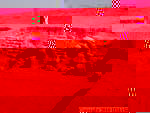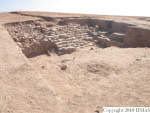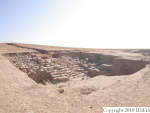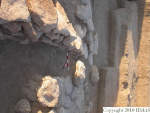| Roster |
Date |
Author |
Record |
| Daily notes about recovery of elements |
2005-08-15 |
mH |
We continued going down in the whole unit (q478). The northwest corner of the unit was especially contaminated. This was due to an earlier German trench in this location. [Input: P815MH.j] |
| 2005-08-16 |
mH |
We continued going down in the whole unit (q500 and q505). Progress was rather slow since we had problems with the elevator located in k5 and jointly used by k15 and k4 (+northern baulk of k5). The north-east corner of the unit is still contaminated by a German trench. [Input: P816MH.j] |
| 2005-08-17 |
mH |
We started by taking a picture of stone feature f185 (v88 and v88a) after which we removed it and its pedestal (f186 q509) and continued down. Starting from q-lot q514 changed the feature into f190, which is garay layer with sandy water deposits. It is very similar to f162 in k14. We excavated two q-lots today (q514 and q518). q518 contains several pieces of a large found located next to a large stone. [Input: P817MH.j] |
| 2005-08-18 |
mH |
We worked mostly on the northern baulk of the unit (f195 q523), but we also continued going down in the whole unit. [Input: P820MH.j] |
| 2005-08-20 |
mH |
We leveled the unit after reaching the 90 m elevation. We then moved the team to help with k102 for the time we need to draw the eastern section of the unit. We then started to take down that baulk in order to connect k5 and k15. [Input: P820MH.j] |
| 2005-08-20 |
vVE |
One final pick run was done in k15 f193 to make its excavation surface more level. We will stop excavating here because we are now at the level of the next ledge of the stepped section at an elevation of 90. [Input: P820VVE1.j] |
| 2005-08-23 |
sC |
Today we finished to remove f206 (the E baulk of k15); two ledges (one in the South and another in the North area of the baulk) were left from yesterday excavation. Once finished we moved the workmen in k5 (where they started to remove the E baulk of k5). [Input: P823SC.j] |
| 2005-08-27 |
mH |
We continued removing the northern baulk (f233). With the help of Shallal the work was progressing faster, although it was still rather slow. This was due to the hardness of the deposit, which was the by now very familiar cement-like deposit. Four q-lots were excavated here today (q614, q623, q627, and q632). [Input: P827MH.j] |
| 2005-08-28 |
mH |
We still had some of the northern baulk left thus we spent most of the day removing it. Its removal has taken us quite a few days due to the hardness of the soil in this location. q633 was collected by the pickmen, while q639 and q654 were recoved during sifting. After we finished removing the baulk, the northern edges of k5 and k15 were parallel. sC drew these sections. We then moved back on top of the loci and started preparing the ledges, which in this unit are diagonal sloping from northwest to southeast with the southwest corner remaining at the 90 m elevation. We continued with the same q-lot we had finished here a few weeks earlier (f193) and excavated one q-lot (q649) with one additional q-lot coming from the sifter (q649). [Input: P828MH.j] |
| 2005-08-29 |
mH |
Yesterday when I strang the limits of the ledges in this unit, I had left a triangluar area in the northeast corner of the unit as well as a stretch along the northern egde of the unit outside the limits of excavation temporarily. I did this so that we could draw the southern edge of k14 and k4. Thus yesterday we had excavated approximately in the middle of the unit. Since we drew the section yesterday, we could now extend the area of excavation to reflect the total area, where we want to go down. Here we filled three qlots. One (f193 q659) came from the excavators and the other two (q660, q674) from the sifter. We also removed one floating stone (f259), which is defined by relays r912, r913, r914, and r915. [Input: P830MH.j] |
| 2005-09-04 |
sC |
Today we continued to dig in k15 f273 until breakfast. We first excavated 2m W from m4213 (q731, q742) and 1m from the W section of k15 (q743). After breakfast I moved Mamu (who was digging here) in k5 to help Shallal in digging f277 W to the elevator. [Input: P903SC.j] |
| 2005-09-05 |
sC |
Today we continued to dig f193 in k5 (q676 and q700). The pottery have been swifted and the swift have been collected in a different qlot (q682). The feature is characterized by a very soft, fine and loose texture, but it presents also some hard layers, difficult to remove; therefore the work is not proceeding very fast in this area. [Input: P831SC.j] |
| 2005-09-05 |
sC |
We did not dig the whole area; the elevator is in fact located in the SW corner of k15, where there will be the step of the section). We dig f273, that is a briky melted and crumble accomulation in the NW corner of k15. Lots of pottery sherds have been collected (q704, q716, and q714, that contains the pottery swifted from both qlots) from today excavation. [Input: P901SC.j] |
| 2009-08-09 |
cJC |
Today we began excavating in k15. Before today we had mostly only cleaned the area and removed the south and west sections to give more room to work. At the beginning of excavation we had what appeared to be several features already showing. We decided the clearest way to excavate would be to follow the west section of k5 across. We were hoping to expose the salmon-colored floor (f359) all the way across the loci in front of the apron f131 and try and follow it around the north turn next to the wall f127 if it turned that way. By following f364 across through the section we found several different features. There is the plate-like accumulation which we is the same as f365 (immediately under f364) which is what we expected based on k5. f365, however, does not continue all the way west. Instead we found a reddish layer which we have not yet really exposed or excavated and some plaster, possibly similar to that found in k5 (f370) or that seen in the west section of k5. I decided we should try and excavate the latest moment in time first and so we removed a small accumulation of f364 in the middle of the northern edge of the square that seemed to possibly be overlaying f372 but when we removed it we found bricky material underneath which is actually overlaid by the gray layer f371. So we decided to stop in that small area and instead to photograph and remove both f339 and f371. We will first remove the flaky structure of f371 and see if it overlays the very hard gray later that is f339 or if it is actually a damaged section of f339. [Input: T809CJC.j] |
| 2009-08-10 |
cJC |
Yesterday we decided that the best strategy was to excavate down from the latest features (f371, f339) and try and follow them in k15 instead of going across from the west baulk of k5. We started by removing f371, the flaky gray layer on top of f339. We wanted to remove the hard gray layer f339. It was relayed and then we began removing it. When we picked the hard layer however it came apart very differently in the two areas where the pickmen were working. Coming down from the north Kamiron found that the hard gray layer was very hard and thick (about 3cm or more) and when picked it removed a 10cm layer underneath as well. Underneath he found the dramatic reddish layer (f348) and a gray layer which we assigned as f374. In contrast, in the SW corner where Mohammed Kher was working we found that f339 was extremely thin and came off easily revealing a dramatic pink layer (f373). This layer is soft and easily damaged with the pick. Because we have now exposed several layers (f373, f348, f374)due to the nature of the removal of f339 we decided to follow the layers across through the section of k5 to see how they relate to the newly exposed layers. In the west section we can see f365 and a thin yellow line which we have assigned f375. We wanted to remove f365 above f375 and see how it comes up against the pink layer f373. It seems that f365 would have covered the pink layer f373 but it was cut by the erosion. By following f365 across from the east to the west we should be able to answer this question. Before we could remove all of f365 we needed to expose the plaster layer (f375) and see its extent. We used the small pick and the brush to expose as much of this delicate layer as possible. Tomorrow we hope to finish exposing the plaster (f375) relay and photograph it before removing it. After we finish with f375 we will continue removing f365 across to see its relationship to the pink (f373). (This daily is revised version of today's strategy entry). [Input: T810CJC.j] |
| 2009-08-11 |
cJC |
We exposed the floor with plaster inclusions (f375), photographed and relayed it and removed it. We then went down following the layers seen in the west section of k5. Once we had cleaned everything we did our best to expose f375, the floor with plaster inclusions. We photographed it when we thought it had reached its full extent but then as we were removing f365 we found it continued and so we photographed it again. After that we removed f375 and started removing the accumulations of f365 by moving from the west section of k5 in a westward direction. In the south portion of k15 f365 came down on top of the salmon-colored floor f359 just as we expected. We did not finish exposing f359 and will work on exposing its extent tomorrow. In the north part of k15 we found the situation was more disturbed possibly due to erosion as we saw in k5 with the erosion of f359 and the brown accumulation of f367. It seems that f367 continues into k15 with some disturbed accumulations (not in nice thin layers of accumulations like f365) and some sherds that are not lying flat as well as some pebbles. We will explore this area tomorrow. [Input: T811CJC.j] |
| 2009-08-13 |
cJC |
We are finished excavating in this locus. It will be backfilled at the end of the season. [Input: T815CJC.j] |
| Formal inconsistencies |
2009-08-26 |
cJC |
After plotting the J2 loci from MZ22 it became apparent that they do not exactly match the squares of the previous years. This is not totally unexpected as we had many problems at the beginning of the season trying to reestablish the squares due to the small number remaining markers in J2 as well as the depth of J2 compared to the remaining markers. The differences are not substantial but should be noted. [Input: T826CJC.j] |
| Roster |
Date |
Author |
Record |
| Elements within locus |
2008-01-31 |
pC |
f58 (topsoil), f65 (layer), f71 (mixed) [Input: S131PC3.j] |
| 2005-08-14 |
sC |
f168 (accumulation D) [Input: P912MH.j] |
| 2005-08-16 |
sC |
f185 (isolated stone) [Input: P912MH.j] |
| 2007-07-20 |
sC |
f185.1 (isolated stone), f185.2 (isolated stone), f185.3 (isolated stone), f185.4 (isolated stone) [Input: S131PC2.j] |
| 2005-08-16 |
sC |
f186 (accumulation D) [Input: P912MH.j] |
| 2005-08-17 |
sC |
f193 (accumulation D) [Input: P912MH.j] |
| 2005-08-19 |
sC |
f195 (accumulation B) [Input: P912MH.j] |
| 2005-08-22 |
sC |
f206 (accumulation D) [Input: P913MH.j] |
| 2005-08-23 |
sC |
f233 (accumulation D) [Input: P913MH.j] |
| 2005-08-27 |
aL |
f259 (isolated stone) [Input: P913MH.j] |
| 2005-09-01 |
aL |
f273 (lens type d) [Input: P913MH.j] |
| 2005-09-04 |
aL |
f305 (lens type d) [Input: P913MH5.j] |
| 2009-09-02 |
cJC |
f338 (mx), f339 (floor, type b), f341 (brickfall) [Input: T830CJC.j] |
| 2009-07-26 |
cJC |
f345 (floating stones), f348 (floor, type a) [Input: T822CJC2.j] |
| 2009-09-02 |
cJC |
f359 (floorsurface in general) [Input: T830CJC.j] |
| 2009-08-19 |
cJC |
f365 (floor, type d) [Input: T819CJC2.j] |
| 2009-09-02 |
cJC |
f366 (erosion cut), f367 (lens) [Input: T830CJC.j] |
| 2009-08-09 |
cJC |
f371 (accumulation D), f372 (brickfall) [Input: T822CJC2.j] |
| 2009-08-10 |
cJC |
f373 (lens), f374 (floor, type c), f375 (floor, type a) [Input: T822CJC2.j] |
| 2009-08-30 |
cJC |
f376 (erosion cut) [Input: T830CJC.j] |
| 2004-07-12 |
ap |
q124 (pottery) [Input: O712MH.j] |
| 2004-07-13 |
mh |
q134 (pottery) [Input: O713MH.j] |
| 2004-07-14 |
ap |
q147 (bones, items, pottery), q152 (pottery) [Input: O717MH.j] |
| 2004-07-15 |
mh |
q163 (items, pottery) [Input: O717MH.j] |
| 2005-08-14 |
sc |
q452 (pottery) [Input: P909MH.j] |
| 2005-08-15 |
vVE |
q478 (bones, pottery) [Input: P909MH.j] |
| 2005-08-16 |
sC |
q500 (pottery) [Input: P909MH.j] |
| 2005-08-16 |
vVE |
q505 (pottery) [Input: P909MH.j] |
| 2005-08-16 |
sC |
q509 (bones, pottery) [Input: P909MH.j] |
| 2005-08-17 |
sC |
q514 (bones, items, pottery), q518 (pottery) [Input: P909MH.j] |
| 2005-08-18 |
sC |
q523 (items, pottery), q532 (pottery) [Input: P908MH2.j] |
| 2005-08-20 |
aL |
q538 (bones, pottery) [Input: P908MH2.j] |
| 2005-08-20 |
vVE |
q544 (pottery) [Input: P908MH2.j] |
| 2005-08-20 |
sC |
q545 (pottery) [Input: P908MH2.j] |
| 2005-08-22 |
sC |
q556 (bones, pottery) [Input: P908MH2.j] |
| 2005-08-23 |
sC |
q562 (items, pottery) [Input: P908MH2.j] |
| 2005-08-25 |
sC |
q599 (bones, pottery) [Input: P908MH2.j] |
| 0000-00-00 |
sC |
q607 (pottery), q614 (bones, pottery) [Input: P908MH2.j] |
| 2005-08-27 |
aL |
q623 (pottery) [Input: P908MH2.j] |
| 2005-08-27 |
sC |
q627 (pottery), q632 (pottery) [Input: P908MH2.j] |
| 2005-08-28 |
sC |
q633 (pottery), q639 (bones, pottery) [Input: P908MH2.j] |
| 2005-08-28 |
aA |
q649 (pottery), q651 (pottery), q654 (pottery), q659 (bones, pottery), q660 (bones, pottery) [Input: P908MH2.j] |
| 2005-08-29 |
aA |
q674 (pottery) [Input: P910MH.j] |
| 2005-08-31 |
aL |
q676 (bones, pottery) [Input: P910MH.j] |
| 2005-08-31 |
aA |
q682 (pottery) [Input: P910MH.j] |
| 2005-08-31 |
sC |
q700 (bones, pottery) [Input: P910MH.j] |
| 2005-09-01 |
mH |
q704 (p.b) [Input: P910MH.j] |
| 2005-09-01 |
sC |
q714 (bones, pottery), q716 (pottery) [Input: P910MH3.j] |
| 2005-09-03 |
mH |
q731 (bones, pottery) [Input: P910MH3.j] |
| 2005-09-03 |
sC |
q742 (pottery), q745 (bones, pottery) [Input: P910MH3.j] |
| 2005-09-04 |
mH |
q757 (bones, pottery) [Input: P910MH3.j] |
| 2005-09-04 |
aL |
q764 (bones, pottery), q765 (pottery) [Input: P910MH3.j] |
| 2005-09-05 |
sC |
q776 (pottery) [Input: P910MH3.j] |
| 2009-07-28 |
cJC |
q846 (bones, pottery) [Input: T729CJC3.j] |
| 2009-08-09 |
sH |
q881 (pottery) [Input: T826CJC2.j] |
| 2009-08-10 |
cJC |
q882 (pottery), q883 (bones, pottery) [Input: T826CJC2.j] |
| 2009-08-11 |
cJC |
q884 (pottery), q885 (bones, pottery), q886 (bones, pottery) [Input: T826CJC2.j] |
| 2009-08-12 |
sH |
q887 (pottery), q888 (pottery) [Input: T826CJC2.j] |
| Relays (applicable to elements) |
2009-08-22 |
cJC |
r1139 (39106 49934 - 8632 / Relay location: SW corner) [Input: T823CJCR.j] |
| Elevation |
2005-09-12 |
mH |
8893 [Input: P913MH7.j] |
| 2005-09-12 |
mH |
9003 [Input: P913MH7.j] |
| Extension of locus or q-lot |
2004-07-08 |
mh |
m3797 [Input: O712MH2.j] |
| Length of two sides |
2004-07-08 |
mh |
400e [Input: O712MH2.j] |
| 2004-07-08 |
mh |
400n [Input: O712MH2.j] |
 [Input: YX24CJC.j]
[Input: YX24CJC.j]




































































